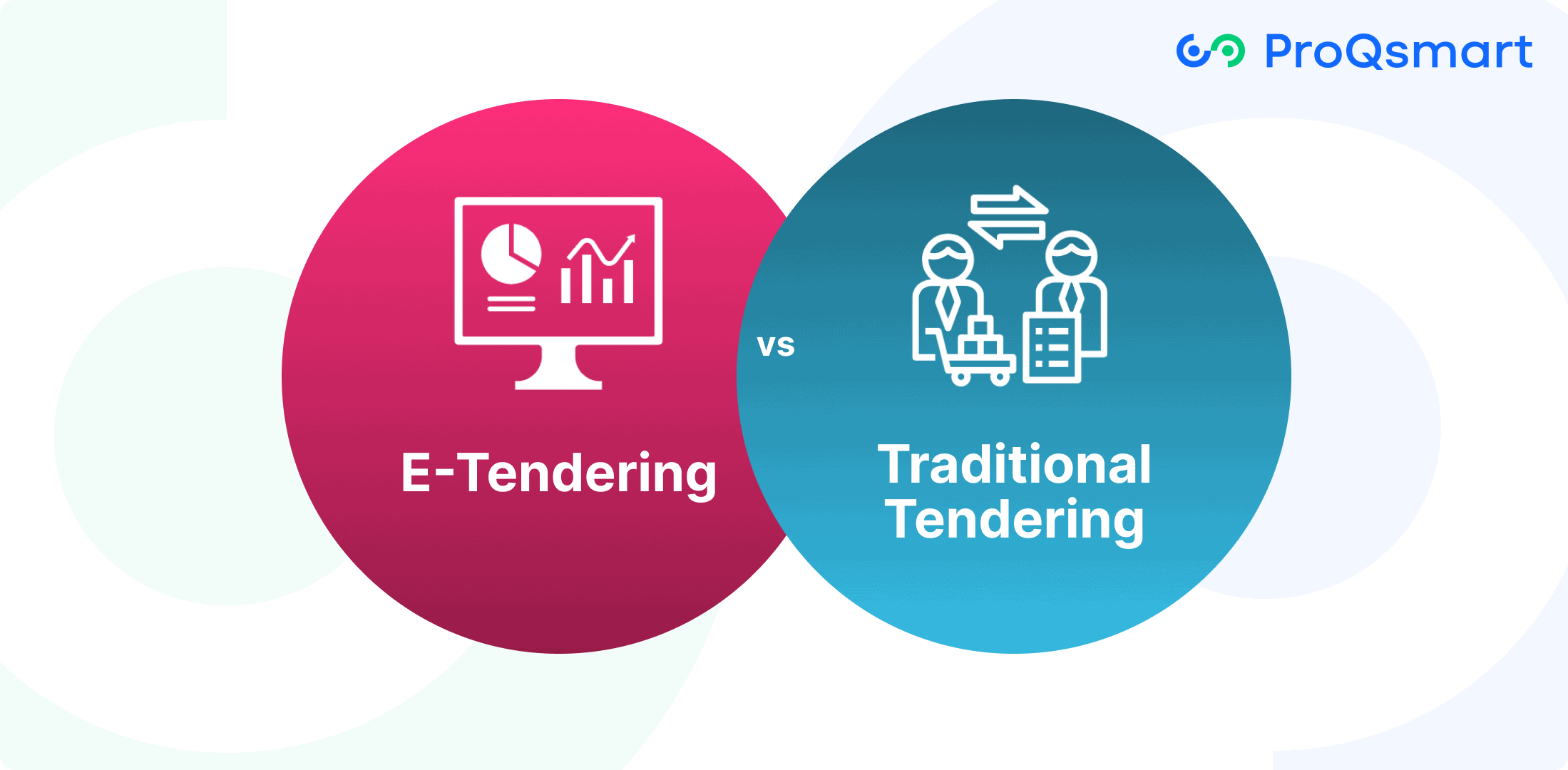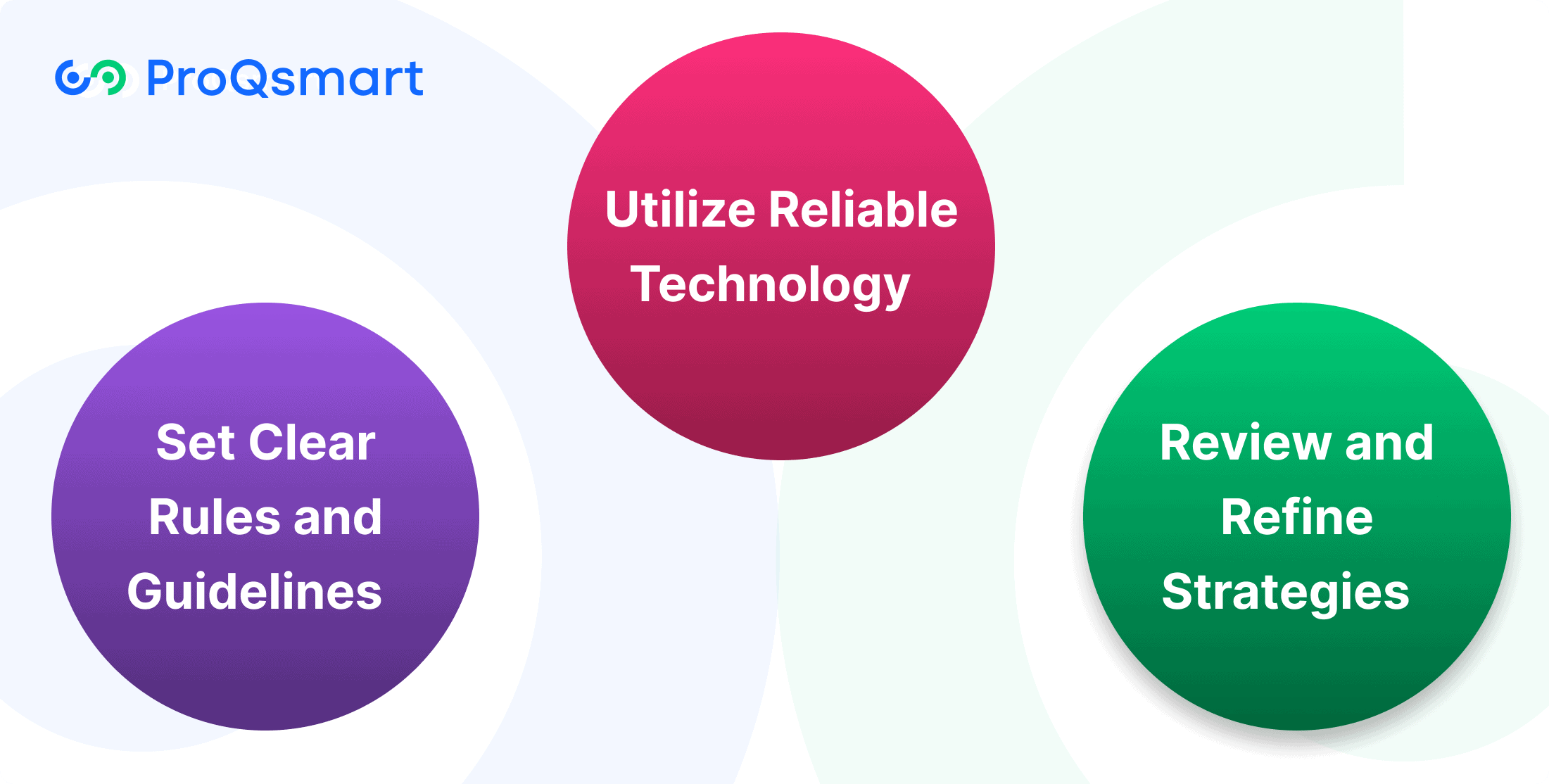eTendering transforms and simplifies the entire procurement process. It allows companies to control tendering operations electronically, fostering transparency, more efficient processes, and reduced costs. eTendering brings an end to outdated paper-based tendering practices and simplifies the whole procurement process.
It streamlines everything from publishing tender documents to evaluating tenders and awarding contracts. Most importantly, it allows for efficient, real-time communication between buyers and suppliers, minimizing time-wasting back-and-forths and creating a collaborative environment.
eTendering makes even the most complex procurements easy with automatic bid evaluation, compliance tracking, and secure document management baked right into the tool. Doing so preserves data integrity all the way through.
Companies can get the competitive advantage by embracing etendering. This approach goes beyond simply fulfilling regulatory requirements to position them to succeed in a rapidly evolving marketplace.
Understanding the advantages and etendering best practices will set you on the right course to maximize your procurement strategies.
E-Tendering vs Traditional Tendering

E-tendering has truly transformed the procurement process by solving many inefficiencies rooted in traditional tendering processes. Traditional tendering is usually still done on paper, requiring large amounts of administrative time and risking human error. This process can delay procurement cycles, increasing lead times between need fulfillment and receiving goods or services.
|
Feature |
E-Tendering |
Traditional Tendering |
|---|---|---|
|
Process |
Smart, efficient, convenient online process. |
Manual, paper-based process. |
|
Paperwork |
Eliminates physical paperwork. |
Relies heavily on physical documents. |
|
Cost Savings |
Minimizes administrative costs by cutting printing, mailing, and storage expenses. |
Higher administrative costs due to paperwork, printing, and postage. |
|
Time Efficiency |
Dramatically accelerates workflows with automated tasks like bid management and document handling. |
Slower workflows due to manual processes and physical delivery of documents. |
|
Data Access |
Provides at-a-glance, real-time reporting clarity into open bids, contracted professionals, and overall supplier performance. |
Delayed or unavailable data, leading to less informed decision-making. |
|
Transparency |
Increases transparency and accountability, building supplier confidence. |
Limited transparency, potentially leading to disputes and misunderstandings. |
|
Collaboration |
Platforms allow for increased collaboration and budget tracking in real time. |
Limited collaboration due to manual processes and lack of real-time data. |
|
Sustainability |
Supports sustainability by saving trees and decreasing pollution from paper production and transport. |
Environmentally wasteful due to extensive paper usage. |
|
Supplier Pool |
Opens door to wider range of suppliers, promoting inclusivity. |
Limited to suppliers within geographical constraints. |
Error Reduction |
Minimizes human errors associated with manual data entry. |
Higher risk of errors due to manual data handling. |
|
Compliance |
Helps organizations meet regulatory requirements and demonstrates compliance during audits. |
More difficult to demonstrate compliance due to lack of audit trails. |
|
Decision-Making |
Real-time data and analytics provide accurate insights into supplier performance, enabling informed decision-making. |
Relies on manual data analysis, potentially leading to slower and less accurate decisions. |
|
Efficiency Improvement |
More than 80% of hotels that have adopted e-procurement have experienced improved efficiency. |
Lower efficiency due to manual processes and lack of automation. |
|
Cost Reduction |
E-procurement systems cutting maverick spending by as much as 30%. |
Higher spending due to lack of spend visibility. |
How Does E-Tendering Works in Procurement Practices?
E-tendering transforms procurement operations by providing a technological infrastructure that consolidates and simplifies the complete tendering journey. It promotes greater efficiency, transparency and accuracy in the procurement process while saving taxpayers and proposers’ money and time substantially.
By streamlining processes through automation and enabling greater collaboration, e-tendering provides a smoother, more efficient process for buyers and suppliers. Here, we take a look at its most important stages and stakeholders.
1. Tender Creation and Publication
The overall process starts with buyers generating a tender on an eTendering portal. This includes the creation of comprehensive tender documents, including scope of work, evaluation criteria and project deadlines.
Complete and clear documentation encourages more qualified bids and reduces miscommunication. Most platforms like ProQsmart have templates that simplify this process, saving users time and providing consistency.
Once completed, tenders are made public in locations where suppliers can easily find and view them.
2. Bid Submission Process
Suppliers respond to the tender notice by entering their bids directly onto the platform. This reduces the cost and hassle of physical paperwork, reducing submission time by a staggering 50% or more.
Suppliers are forced to comply with strict timelines and deliver bids that are not only on-time but thorough and precise. ProQsmart automates document creation and administration to save time and money.
Finally, it increases transparency, enabling all suppliers to have greater access to important information and build confidence.
3. Bid Evaluation and Award
Buyers then evaluate bids according to established criteria, employing AI and other tools to enhance accuracy and transparency in the evaluation process.
Opening up visibility into submissions creates a level of trust among all participants and helps drive competitive behavior. Additional feedback delivered via portals such as ProQsmart further allow suppliers to improve future submissions, forming a collaborative partnership.
4. Contract Management
After the award, buyers create and manage contracts using the eTendering system. ProQsmart makes oversight easy, with powerful features.
It delivers supplier performance monitoring and automated workflows, which protect compliance, deliver cost savings, and fortify supplier relationships.
Exploring Dynamic Pricing in E-Tendering
Dynamic pricing is changing the game for eTendering. It revolutionizes procurement strategies to better respond to dynamic and unpredictable market forces. Dynamic pricing provides an unparalleled flexibility compared to rigid fixed-price methods.
It allows all suppliers to change their bids in real-time during the entire tendering process. This ability prevents prices from becoming out of date and uncompetitive with no consideration of new market dynamics. As a result, it gives organizations a much more flexible and adaptable approach to procurement.
How Dynamic Pricing Operates
The mechanics of dynamic pricing are largely impossible without technological and well-informed market intelligence. Dynamic pricing forces suppliers to compete by constantly recalibrating their bids in real-time on electronic tendering platforms.
They efficiently adapt to changes in market demand, supply chain shortages, and material price increases. For instance, during a tender for construction materials, a supplier might lower their bid if market intelligence indicates a drop in raw material costs, ensuring competitiveness without compromising profitability.
This is where platforms like ProQsmart come in, using AI to simplify these processes. By streamlining communications and supporting dynamic pricing, ProQsmart equips public works suppliers with the kind of guided insight that allows them to make data-driven decisions.
Enhanced capabilities such as supplier performance monitoring and cost tracking bring visibility and accountability across the entire procurement process to keep organizations informed and compliant.
Static Bidding vs. Dynamic Pricing
Static bidding, defined by non-negotiable and rigid pricing, usually has a difficult time keeping up with the dynamic and holistic market. Dynamic pricing encourages market competition.
By factoring in actual market conditions, it incentivizes suppliers to bring their best possible prices to the table. ProQsmart provides the competitive edge that produces lasting cost savings.
Crucially, it fosters a culture for transparency and drives supplier relationship management, making procurement a true force for your organizational mission.
Advantages of Real-Time Bidding
Real-time bidding (RTB), as featured in ProQsmart’s unique e-tendering module, is completely overturning conventional methods for increased efficiency and accuracy. First, it replaces old-fashioned procurement with a dynamic, data-driven desire.
RTB allows real-time interactions that foster more competition and transparency among suppliers. This new multi-attribute methodology delivers unprecedented benefits to procurement practitioners.
Achieve Price Precision
RTB increases pricing precision as it enables sellers to raise or lower their prices based on current competitive demand. This fast-moving context opens the door for potentially major cost savings, with vendors constantly improving their bids in order to win the contract.
For example, a construction company could use ProQsmart’s AI-powered platform to analyze live construction data. This enables them to make the right decisions, stay within their budget, and eliminate wasteful spending.
By incorporating real-time, granular analytics into the process, RTB enables better pricing decisions, helping companies drive improved profit margins.
Accelerate Tender Closures
The flexible nature of RTB dramatically reduces the length of tenders. Real-time adjustments remove the lag time created by fixed/static bidding approaches, allowing procurement teams to make and accept final decisions more quickly.
ProQsmart’s automated workflowsand document management capabilities simplify the evaluation stages. This allows for efficient resource distribution and helps maintain schedules for projects.
Accelerated closures save significant time and increase overall operating efficiency, allowing organizations to remain one step ahead of their competitors in today’s constantly changing business landscape.
Adapt to Market Changes
Market conditions are always subject to sudden change, and RTB provides the nimbleness that enables you to adapt with purpose. With real-time data available at their fingertips, suppliers can make informed decisions on how to bid, allowing them to stay competitive while maximizing profits.
ProQsmart’s real-time tracking and compliance capabilities offer procurement professionals unparalleled insight for guiding effective decision-making amid constant change and uncertainty.
Engage Vendors Effectively
By ensuring that vendors are integrally connected, RTB helps build effective relationships. With ProQsmart’s collaboration tools, suppliers will always know what is happening and be more actively involved.
This leads to superior performance and enduring relationships.
Potential Pitfalls of Dynamic Pricing
Dynamic pricing provides incredible flexibility in the procurement processes. However, it introduces a raft of other complications that need to be mindfully addressed in order to produce equitable and successful outcomes in the tendering process. Addressing these challenges is key to promoting more sustainable procurement practices.
Supplier Strain and Capacity
Dynamic pricing can create excessive burdens on smaller providers, particularly those with less financial or operational bandwidth. These companies will struggle to compete in highly accelerated auction settings. As a result, they’re missing out on opportunities and getting left out of the most important projects.
For example, a smaller vendor without sophisticated bidding technology will likely struggle to keep up with bigger, better-armed vendor-equipped vendors. To address this concern, we need to adopt stronger protective measures. This covers capacity-building initiatives, ProQsmart, user-friendly e-tendering platforms that simplify bid preparation, and deliver accessible resources for all suppliers.
Striking the right balance between competition and fair opportunity creates a more diverse and competitive supplier base.
Information Overload Challenges
Procurement teams adopting dynamic pricing models frequently find themselves overwhelmed with a deluge of real-time data. Yet this tsunami of new information might lead to analysis paralysis. Without the right systems in place, this leaves procurement making it harder to glean valuable insights and bogging down procurement cycles.
ProQsmart’s AI-driven platform automates data interpretation, which helps deliver actionable insights in a prompt manner. This enables teams to focus on higher-level strategic decisions rather than getting lost in the data weeds. Training procurement professionals to effectively interpret and utilize real-time data will optimize decision-making during the bidding process even more.
Ensuring Equity and Fairness
Equity concerns arise when larger suppliers are often the ones with the resources to game dynamic pricing processes. Clearly defined evaluation criteria and equitable award practices will go a long way towards maintaining faith in the process from both industry and public stakeholders.
ProQsmart promotes equity by allowing easy and transparent documentation. It helps create auditable sourcing data, while leveling the playing field so all suppliers can compete fairly to win business.
Technology Dependency Risks
Dynamic pricing makes a business very dependent on technology, putting them at risk for things like system failure in the midst of e-live bidding. These shocks may not only swamp procurement workflow but wash away public confidence from all participants.
ProQsmart reduces these risks with strong fail-safe generators, detailed automated workflows, and great relay to team sharing platforms. Companies need to have contingency emergency plans in place as well to ensure continuity of service during crucial times.
Tips for Successful Dynamic Pricing

Dynamic pricing has quickly become a vital weapon for organizations looking to stay competitive, particularly in the realm of e-tendering. By using dynamic pricing to raise or lower prices depending on demand, competition, or other factors, enterprises can be more profitable and efficient.
A careful implementation plan not only makes dynamic pricing work, but builds trust with stakeholders.
Set Clear Rules and Guidelines
Setting explicit parameters is central to the concept of dynamic pricing. Establishing bidding rules, including floors, ceilings, or increments for prices during auctions, will ensure a level playing field for all bidders.
For instance, when implementing initial pricing, companies can attract engagement from newcomers to the field while still reserving the right to uphold minimum standards. Communicating expectations, such as submission formats or deadlines, ensures all participants are aligned.
Clarity in these rules fosters trust between all stakeholders, facilitating a productive working relationship. Platforms such as ProQsmart make this process easier by automating workflows, ensuring compliance, and offering transparency like never before.
Utilize Reliable Technology
Your dynamic pricing effort will fail without the robust technology to support it. User-friendly interfaces such as ProQsmart promote seamless bidding in the tendering process, while AI-driven analytics offer actionable insights to improve decision-making.
Review and Refine Strategies
Like everything else, continuous improvement is the name of the game. Continuously evaluating pricing initiatives through stakeholder feedback or platforms such as Omnia and etendering tools helps hone strategies.
Integrating E-Tendering with Existing Systems
Ensuring seamless integrations between e-tendering platforms and their existing procurement solutions is essential to maximizing efficiency and realizing cohesive procurement journeys. By connecting these systems, you build a unified ecosystem that streamlines processes, offers instant visibility, and minimizes operational challenges.
This integration enhances communication and transparency between all stakeholders involved in the process. At the same time, it guarantees compliance with regulatory standards while reducing costs and time.
ERP System Integration
Integrating e-tendering platforms with ERP systems starts with mutual compatibility. This means understanding what are the main touchpoints where data like supplier details, policy mappings, budgeting information, etc., can easily move between systems.
Through centralizing all procurement data within an ERP, organizations gain complete visibility to all spend, which allows for more informed decision-making and improved supplier relationships. ProQsmart leverages machine learning to smarten workflows with automation.
This method focuses procurement within the parameters of budgetary restrictions and makes certain that procurement goals aid the overall business objectives. With capital expenditures tracked in real time, it makes operational alignment all the stronger.
Procurement System Integration
Harmonizing e-tendering solutions with current procurement systems needs to be centered around seamless data sharing and streamlined workflows. Additionally, automated processes like document management and bid evaluation remove the chances of manual errors while accelerating tender cycles.
ProQsmart is particularly strong in the handling of bills of quantities and tracking of subcontractor performance. This integration opens up a centralized view of all procurement activities, increasing transparency and collaboration between departments.
Data Migration Strategies
Working through data migrations to e-tendering platforms requires attention to detail and thorough testing. Maintaining a seamless and accurate data transfer is critical, particularly as organizations increasingly rely on real-time analytics, supplier performance tracking, and more.
Wide scale testing greatly minimizes headaches and ensures that all systems are online and functioning properly once migrated. This means that platforms like ProQsmart can deliver unmatched visibility and auditable sourcing information.
Conclusion
E-tendering adds speed and clarity to the procurement process. It makes frustratingly complex processes easier and paves the way for better, more intelligent supplier experiences. Flexibility is built into dynamic pricing, maximizing your real-time convenience as well as opportunity to lock in the most competitive rates possible. If deployed correctly, these tools save dollars, increase transparency, and make government more efficient.
Embracing e-tendering doesn’t require you to rip and replace your current systems. It doesn’t mean weakening them. Adoption integration is key to streamlining workflows and unlocking the full potential of technology. Picking the right tools to ensure your unique needs are met is crucial to getting results.
When considered holistically, e-tendering goes beyond technology. It’s about realizing value. By keeping an eye on the landscape and preparing for these changes, you position yourself at the forefront of a rapidly evolving market. Ready to revolutionize your procurement process?Explore ProQsmart and book a demo today to discover how our e-tendering solutions can fuel long-term growth and build deeper partnerships.





